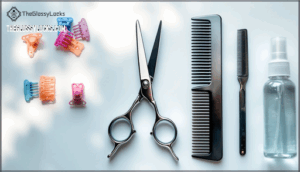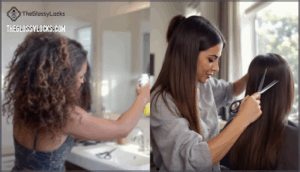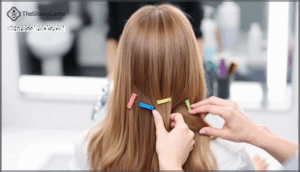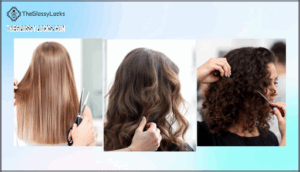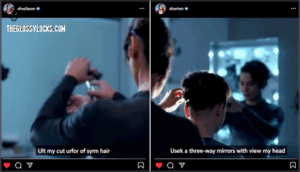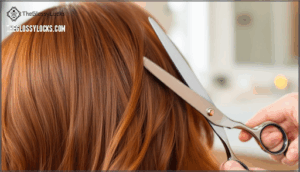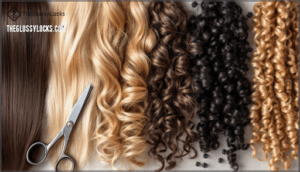This site is supported by our readers. We may earn a commission, at no cost to you, if you purchase through links.
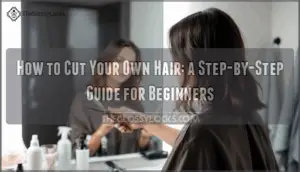 You’ve probably seen the horror stories—someone trimming their bangs at 2 a.m. with kitchen shears, only to show up at work looking like they lost a fight with a lawnmower. Learning how to cut your own hair doesn’t have to end in disaster, though. With the right tools and techniques, you can manage basic trims, tackle split ends, and even create simple layers without booking an appointment or spending $50 every six weeks.
You’ve probably seen the horror stories—someone trimming their bangs at 2 a.m. with kitchen shears, only to show up at work looking like they lost a fight with a lawnmower. Learning how to cut your own hair doesn’t have to end in disaster, though. With the right tools and techniques, you can manage basic trims, tackle split ends, and even create simple layers without booking an appointment or spending $50 every six weeks.
The secret isn’t magic hands or a cosmetology license—it’s understanding what your hair needs and knowing which cuts you can safely manage at home versus which ones demand professional help. Whether you’re maintaining a style between salon visits or embracing full DIY mode, a few solid techniques will keep your hair looking intentional instead of improvised.
Table Of Contents
- Key Takeaways
- Is It Okay to Cut Your Own Hair?
- Make Sure You Have The Right Tools
- Wet or Dry: Which is Better for Trimming?
- Sectioning Your Hair for a Successful Cut
- Step-by-Step Haircutting Techniques
- Techniques for Different Hair Types
- Maintaining Hair Health Between Salon Visits
- Frequently Asked Questions (FAQs)
- What hair products should I use during and after a DIY haircut?
- How often should I cut my hair at home?
- How can I make sure I don’t cut too much hair?
- What techniques should I use to cut different hair lengths?
- Is it harder to cut my own hair or someone else’s?
- How do I fix uneven sections after cutting?
- Can I cut my own bangs at home?
- Whats the best way to trim the back?
- How do I know when to stop cutting?
- Should I cut hair in natural or artificial light?
- Conclusion
Key Takeaways
- Invest in professional haircutting scissors and avoid kitchen shears or craft tools, since dull blades crush hair strands and create split ends instead of clean cuts.
- Cut curly or textured hair when it’s completely dry to see the natural curl pattern and avoid surprise shrinkage, while straight hair can be cut wet for more precision and control.
- Stick to simple maintenance like trimming split ends and dusting damaged tips at home, but leave complex techniques like layering, bangs, and drastic style changes to professionals to avoid costly mistakes.
- Section your hair into four quadrants and check symmetry from multiple angles using mirrors, trimming conservatively in small amounts since you can always cut more but can’t restore what’s gone.
Is It Okay to Cut Your Own Hair?
Cutting your own hair can save time and money, but it’s not always the right move. You need to know when it’s safe to grab the scissors and when you’re better off booking a salon appointment.
Let’s break down what you should consider before making that first snip.
Risks and Benefits of DIY Haircuts
Cutting your own hair offers financial savings—up to $7,650 over 15 years—and unparalleled scheduling flexibility. You can maintain hair health and maintenance between salon appointments.
However, technical errors are common: 73% of DIY haircutting attempts result in uneven cuts, and 92% of first-timers make mistakes. Common pitfalls include poor rear visibility and inadequate tools.
While home hair cut options provide salon alternatives and emotional effects like increased control, complex styles often require professional correction within three months. A bad haircut may require professional hair care.
Situations When You Should Avoid Self-cutting
While DIY trims work for many, some situations call for salon alternatives instead. Individuals without training are 93% more likely to achieve uneven results, and attempting complex styles like layers, bangs, or a pixie cut leads to unsatisfactory outcomes in 80% of cases. Skip self-cutting if you’re dealing with:
- Vision Problems or Physical Limitations that make precise cutting difficult—uncorrected visual impairments increase errors by 2.5 times
- Scalp Conditions like psoriasis or eczema, which flare up in 58% of improper home haircuts
- Drastic Changes requiring unfamiliar techniques—major transformations cause regret needing professional correction in 64% of cases
When you’re targeting split ends or simple maintenance, home cutting makes sense. Using high quality scissors is essential for achieving the best results. For everything else, professionals deliver safer results.
Common Mistakes to Watch Out For
Even when you know what to skip, it’s easy to mess up the execution if you’re not careful about technique. Uneven cuts happen when you rush or use dull scissors that fray ends. Over-cutting destroys length you can’t restore. Bad lighting hides mistakes until it’s too late. Ignoring texture—especially with curly hair—leads to wonky results when dry. These DIY hair cutting pitfalls turn home hair cut sessions into regret.
Make Sure You Have The Right Tools
You can’t cut your own hair properly without the right gear. Professional haircutting scissors are non-negotiable—kitchen shears won’t cut it, literally.
Let’s break down what you actually need, why sharp tools matter so much, and what you should skip entirely.
Essential Tools for At-home Haircuts
Before you pick up anything to snip, you’ll need to gather the right gear—think of it as assembling your toolkit before tackling any home project. Start with professional haircutting scissors, not kitchen shears—you can find budget options on Amazon or at Sally’s that won’t break the bank.
Add a carbon comb to reduce static and keep hair under control. If you’re trimming shorter styles, consider clippers from reliable brands like BaByliss Pro or Wahl for consistent results.
Why Sharp Scissors Matter
When your scissors aren’t sharp enough, you’re basically crushing and fraying each strand instead of making a clean cut—and that’s a fast track to split ends that travel up the hair shaft. Dull blades force you to saw through strands, creating damage that no styling product can fix.
Professional shears made with Japanese steel give you the precision you need for clean cuts that protect hair health.
What Tools to Avoid and Why
Kitchen scissors, beard trimmers, and craft shears might seem like quick fixes, but using the wrong tools can turn a simple trim into a hair emergency. Dull scissors and cheap clippers crush hair strands instead of cutting cleanly, creating split ends that travel up the shaft.
Kitchen shears aren’t designed for hair’s delicate texture, and beard trimmers snag and pull, leaving uneven results.
Invest in proper styling shears and quality hair clippers—your hair’s health depends on it.
Wet or Dry: Which is Better for Trimming?
You’ve got your scissors ready, but should your hair be wet or dry when you make that first snip? The answer depends on your hair type and what you’re trying to achieve.
Let’s break down when to reach for the spray bottle and when to cut it dry.
Pros and Cons of Wet Vs. Dry Cutting
Cutting your hair wet gives you more control and precision, but dry cutting shows you exactly what you’re working with in real time. Wet cuts make it easier to section and snip evenly, especially for straight hair.
Dry cutting works better for curly or textured hair since curls shrink when wet—you’ll avoid surprise length changes. Hair type matters when choosing your approach.
How to Prep Your Hair for Each Method
Before you make a single cut, prep work sets the stage—skip this step and you’ll end up fighting your hair instead of shaping it.
For wet cutting, cleanse and condition your hair, then towel-dry until damp. Use a carbon comb for detangling methods that reduce static.
For dry cuts, work with completely dry, styled hair—no product application needed. Sharp tool selection matters either way.
When to Choose Each Approach Based on Hair Type
Your hair type holds the answer—straight strands behave differently than curls, and choosing the wrong method can turn a simple trim into a lopsided disaster. Match your hair texture choice to the cut:
- Straight or fine hair: Wet cutting shows precise lines and reveals damage level cut clearly
- Curly or textured hair: Dry cuts respect curl pattern needs and natural volume
- Thick or layered styles: Consider density considerations—wet for blunt trims, dry for desired style shaping
Your DIY cut succeeds when hair cutting techniques align with your hair care routine.
Sectioning Your Hair for a Successful Cut
Good sectioning sets you up for an even, professional-looking cut. The technique you’ll use depends on whether your hair is straight, wavy, or curly.
Here’s how to divide your hair properly and keep everything symmetrical.
How to Properly Section Hair
Think of sectioning like drawing a road map on your head—it’s the only way to keep your cut organized and avoid that lopsided disaster you’ve been dreading.
Start with a center part down the middle, then divide your hair into four quadrants—two in front, two in back. Use sturdy hair clips to secure each section, keeping them tangle-free and out of your way.
Check your mirror use from multiple angles to verify your parting precision is spot-on before you make any cuts.
Techniques for Straight, Wavy, and Curly Hair
Once you’ve got your sections mapped out, the way you cut each one depends entirely on what your hair does naturally. Straight hair trims work best with clean, horizontal cuts—pull sections forward and snip straight across with your haircutting scissors.
Wavy hair layers need angled cuts to improve texture, while curly hair shaping requires vertical snips to remove weight without losing bounce.
Your hair type blending technique determines whether your DIY cut looks intentional or accidental.
Tips for Even Length and Symmetry
Even a perfectly executed sectioning job falls apart if one side ends up shorter than the other. Check your DIY cut by parting your hair in multiple directions and comparing lengths in a three-way mirror.
Pull matching sections forward from each side—your visual guides for symmetry—and trim only what’s needed. Section blending and mirror usage prevent uneven haircutting techniques before they become permanent mistakes.
Step-by-Step Haircutting Techniques
Now that you’ve got your hair properly sectioned, it’s time to pick up those shears and start cutting.
The techniques below will walk you through the most common at-home cuts, from simple trims to face-framing angles. Each method builds your confidence while keeping your hair healthy and even.
Basic Trimming for Straight Hair
Trimming straight hair at home starts with bringing clean, detangled sections forward so you can see exactly what you’re cutting. Use sharp professional shears and snip at an angle for a softer look or straight across for blunt edges.
Check your progress by parting your hair in different directions, confirming both sides match in length. This haircutting technique helps you maintain length while keeping ends healthy between salon visits.
Cutting Split Ends Without Losing Length
If you want to clean up split ends but keep your hard-earned length, target just the damaged tips with sharp shears and snip away only what’s frayed. This dusting technique removes barely a quarter-inch, focusing on hair maintenance without sacrificing progress.
You’ll preserve hair elasticity while practicing preventative care that extends time between major trims. Micro-trimming keeps ends sealed and healthy, so you can grow your hair longer without constant breakage holding you back.
Face-framing Angles and Layers
Face-framing angles add instant polish to your cut—but one wrong snip can leave you with a lopsided look that takes months to fix. Pull your hair forward and create a gentle angle by cutting slightly longer near your chin, shorter as you move toward the back.
This face shape-flattering technique works with your hair texture, not against it. When layering hair at home, start conservative—you can always trim more, but you can’t put it back.
Blending and Checking for Evenness
After you’ve shaped those angles, the real test is making sure both sides actually match—and that means checking your work from every angle you can think of. Part your hair in different directions to spot uneven sections.
Here’s your symmetry checklist:
- Pull matching sections forward for length comparison
- Check angle matching by holding strands side-by-side
- Use directional parting to reveal any blending gaps
Trim small bits where needed until both sides mirror each other perfectly.
Techniques for Different Hair Types
Not all hair is created equal, and the techniques that work for one type might leave another looking uneven or damaged. Your hair’s natural texture changes how you should approach cutting it at home.
Let’s break down what works best for straight, curly, thick, fine, and textured hair so you can tailor your technique to your specific needs.
Cutting Straight Vs. Curly Hair
Straight hair shows every mistake in sharp relief, while curly hair forgives wobbles and hides uneven snips in its natural texture. When you’re doing home haircut work, straight strands need precise, straight-across cuts, while curly patterns let you use point-cutting methods that weave into the curl.
| Factor | Straight Hair | Curly Hair |
|---|---|---|
| Texture Differences | Shows every cut clearly | Texture masks irregularities |
| Cutting Methods | Straight, blunt lines | Point-cutting, dry trimming |
| Shrinkage Factor | Minimal length change | Shortens considerably when dry |
| Styling Post-Cut | Reveals mistakes immediately | Hair styling hides imperfections |
Always account for shrinkage with curl patterns—what looks right wet might bounce up inches shorter during hair care routines.
Creating Volume and Texture in Long Hair
Long hair can fall flat and lifeless without the right cut, but graduated layers breathe movement and dimension into every strand. Long layers remove weight without sacrificing length, giving you root lift and swing.
Try point cutting or texturizing shears to soften blunt ends—these hair trimming techniques create natural texture that makes hair styling easier. Razor cutting works too, but requires steady hands and proper home hair care afterward to prevent split ends.
Why Layering at Home is Tricky
Layering is like building a house of cards—one wrong snip throws the whole structure off. This technique’s difficulty requires professional training in angle work and tension control that takes years to master.
You risk uneven layers when cutting your own hair because it’s tough to see the back or maintain consistent angles. Even minor mistakes create choppy sections that grow out awkwardly.
For basic home haircut maintenance, stick to trimming ends—save complex hair styling for the pros who’ve done their risk assessment.
Tips for Thick, Fine, and Textured Hair
Each hair texture has its own rulebook, and working against it turns trimming into a wrestling match you won’t win. Thick hair needs thinning at the ends—use scissors vertically to remove bulk without shortening length. Fine hair volume comes from blunt cuts, not layers that make it look thinner.
For textured hair care, always cut curly hair dry so you see its natural shape.
Product recommendations matter too—lightweight sprays work better than heavy creams during home hair cuts.
Maintaining Hair Health Between Salon Visits
Keeping your hair healthy between salon appointments doesn’t require complicated routines or expensive products. A few simple habits can prevent damage and keep your cuts looking fresh longer.
Here’s what you need to focus on to maintain strong, healthy hair at home.
Preventing Split Ends and Breakage
While you can’t stop split ends from forming entirely, knowing how to spot and address them before they travel up the hair shaft makes all the difference in keeping your lengths strong. Regular trims with sharp shears target damage without sacrificing length.
Between cuts, careful treatment and proper hydration protect against breakage. Protective styles also minimize daily stress on your ends, helping you maintain hair health and extend time between appointments.
How Often to Trim at Home
Most stylists recommend trimming every 8 to 12 weeks to catch split ends before they cause real damage, but your hair’s condition and goals should guide your schedule. If you’re growing out your hair, you can stretch it closer to 12 weeks between cuts. Shorter hairstyles need more frequent attention—every 6 to 8 weeks—to maintain shape.
Check your ends regularly. Visible damage means it’s time for a trim, regardless of how long it’s been since your last haircut.
Home Care Tips for Stronger, Healthier Hair
Between regular trims, you can protect your hair with a few simple habits that make a real difference. Start with scalp health—massage your scalp to boost circulation and support hair growth.
Eat protein-rich foods and stay hydrated, since diet impacts your hair’s strength from the inside out.
Choose sulfate-free products that match your hair type, and always use heat protection before styling. These beauty tips keep your hair strong between cuts.
Extending Time Between Professional Appointments
When you master at-home maintenance, you can stretch your salon visits from every six weeks to three or even four months without sacrificing quality. DIY trims address split ends, while root touch-ups and protective styling keep your look fresh.
Quality products and scalp health routines support stronger hair between appointments. These hair styling tips give you control—cutting your own hair with the right hair tools and equipment makes salon alternatives work for you.
Frequently Asked Questions (FAQs)
What hair products should I use during and after a DIY haircut?
You don’t need products during cutting—just work with clean, dry hair.
Afterward, apply a light leave-in conditioner or serum to smooth ends and add shine. Heat protectant helps if you style afterward.
How often should I cut my hair at home?
You’ll get the best results by trimming every 8 to 12 weeks. This trim frequency keeps split ends in check and aids healthy hair growth without sacrificing length.
Adjust based on your damage assessment and hairstyle maintenance needs.
How can I make sure I don’t cut too much hair?
Think of trimming like editing a manuscript—you can always cut more later, but you can’t undo what’s gone. Start by cutting less than you think you need. Use your fingers as a visual guide, measuring carefully before each snip with your haircutting scissors.
Trim conservatively—you can always cut more, but you can’t undo what’s gone
Take before-after photos between sections to track progress. Practice patience with incremental trimming—small cuts prevent disasters.
Length assessment is easier when you pause between passes. This approach keeps your haircut under control and your confidence high.
What techniques should I use to cut different hair lengths?
For bangs, use sharp haircutting scissors and trim small amounts at a time. Short hair needs precision—cut less than you think.
Medium lengths allow more flexibility with layering techniques. Long hair works well with point cutting to avoid blunt lines.
Barbering techniques help blend shorter sections smoothly.
Is it harder to cut my own hair or someone else’s?
Cutting someone else’s hair is actually a million times easier than doing your own. When you’re cutting your own, visual limitations and coordination difficulty make it tough—you can’t see the back without a three-way mirror, and your scissors hand feels backwards.
Self-cut challenges disappear when cutting someone else because perspective matters.
How do I fix uneven sections after cutting?
If you spot length discrepancies, don’t panic. Part your hair in different directions and do a visual assessment. Use scissors to make small, careful cuts where needed, blending uneven areas with point cutting.
For major sectioning errors causing breakage or an unfixable haircut, professional help is your best move.
Can I cut my own bangs at home?
Yes, you can trim your own bangs at home—think of it as a telegraph message: keep it short and clear. Use sharp haircutting scissors, cut dry hair in small sections, and trim less than you need. Bangs are unforgiving, so go slow.
Whats the best way to trim the back?
Trimming the back is tricky without help. Use a three-way mirror or handheld mirror to check angles while cutting.
Section hair horizontally, bring small pieces over your shoulder, and snip conservatively. This DIY beauty approach requires patience and careful blending for symmetry.
How do I know when to stop cutting?
Your eyes might be your best tool here. Stop when you’ve removed damaged ends and achieved your target length.
Check for evenness by parting your hair multiple ways—front, side, center. Compare both sides in the mirror.
If you’re uncertain about length assessment or style goals, take a break and revisit it.
Should I cut hair in natural or artificial light?
Natural light is best for a haircut—it shows true color perception and shadow clarity without distortion.
If cutting at night, use bright white bulbs to reduce glare and maintain light consistency for accurate hair styling.
Conclusion
You’ll never become a master stylist overnight, but learning how to cut your own hair puts real control in your hands. Start with small trims, respect your hair’s natural texture, and don’t rush the process.
The difference between a confident cut and a kitchen-shears catastrophe comes down to patience and the right technique. Keep your tools sharp, your sections clean, and your expectations realistic.
You’re not aiming for flawlessness—you’re building a skill that saves time, money, and unnecessary salon trips.
- https://www.youtube.com/channel/UCR6Jv1wniCG_3gdCo_f8_qA
- https://www.consumercredit.com/blog/cut-your-own-hair-to-save-money/
- https://hairicc.com/diy-vs-professional-haircut-leave-it-to-hairicc/
- https://melvindurai.com/2020/05/01/cutting-your-own-hair/
- https://www.wsj.com/articles/do-it-yourself-haircuts-the-pros-grade-the-amateurs-11589371206

